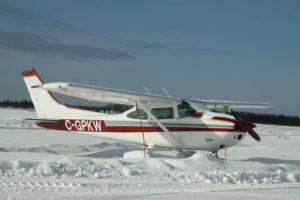 The last few weeks of winter are always a doozy. We’re ready for sunny, warm spring weather (and ideal flying conditions)… but the weather usually has other ideas!
The last few weeks of winter are always a doozy. We’re ready for sunny, warm spring weather (and ideal flying conditions)… but the weather usually has other ideas!
Some of our students think they should cancel their lesson if the temperature drops below zero or if there’s snow in the forecast. Not necessarily true – you can learn some incredibly valuable skills by learning to prepare, take off, and land in wintery conditions. It’s much better to master these skills with a flight instructor than to find yourself unprepared when winter weather sneaks up.
Whether you’re a new recreational flight student or a seasoned commercial pilot, here’s how to prep for winter flying.
1. Take advantage of winter-weather training opportunities.
Western Pennsylvania experiences all kinds of weather, so our students have no shortage of learning opportunities. While our instructors would never put you in a dangerous situation, we encourage our students to practice in controlled conditions for snowy runways, strong winds, and low-visibility conditions.
Before, during, or after a snow event, talk to your instructor about the published NOTAM. They’ll determine whether you should continue with your lesson (or perhaps use our Redbird Simulator instead). Either way, we’ll help you practice soft-field takeoff and landing. Just like driving a car, take it slow and stay aware of your surroundings and you’ll be fine.
2. Expect the unexpected from fall through spring.
Cool weather on the ground can quickly turn to cold, snowy weather aloft. The cabin may feel warm and cozy, but you should always carry cold weather gear when the temperature starts to drop below freezing. You never know when you might have to make an emergency landing. We recommend packing a bag with the following items: extra layers of clothing, gloves, hats, socks, a protein bar, a bottle of water, and (most importantly) your cell phone and a power source.
3. Get familiar with cold-weather procedures.
Unless you’ve had a recent FAA pilot checkride, you might not have read your Pilot’s Operating Handbook recently. Pull it out and get familiar with each aircraft’s cold weather operating limitations, normal and emergency procedures, battery limitations, and other cold weather considerations.
4. Think about frost formation.
You should not attempt flight if there is frost on the windows that would decrease visibility. Frost on your wings or flight control surfaces can reduce the lift generated by your wings, which could cause you to crash on takeoff.
We keep our planes in the hangar as much as possible during the winter. This helps ensure that you won’t have to wait for frost to melt before your lesson. If you’re an aircraft owner, keeping your plane warm and dry is usually the easiest and cheapest solution. In a pinch, you can also position your plane facing the sun to melt frost, or pay the FBO to apply a heated deicing solution.
Keep in mind, as well, that frost can form on the wings and tail in as little as 30 minutes. So if you leave your plane outside in the winter for even a short time, you may have to deal with a coating of frost before you can safely take off.
5. Be aware of cold-weather limitations.
Your engine is sensitive to cold weather. Avoid practicing touch-n-gos, simulated engine failures and stalls when the weather is below 20 degrees. Again, talk to your instructor about which maneuvers and methods you’d like to practice. We may steer you away from certain maneuvers until the weather warms up, or take you inside to the Simulator to practice in a controlled environment.
6. Report the conditions you experience.
Pilot reports (PIREPs) are incredibly useful for other pilots. Pilots should report temperatures, turbulence, visibility, and cloud coverage because it’s the most accurate way for other pilots to know what to expect. You can report weather conditions to Air Traffic Control or online to weather service websites. Your flight instructor can walk you through these good habits.
A little white stuff on the runway shouldn’t stop your flight lesson. With a skilled flight instructor by your side, you can learn incredibly valuable skills for take-off, flight, and landing when winter weather inevitably pops up.
